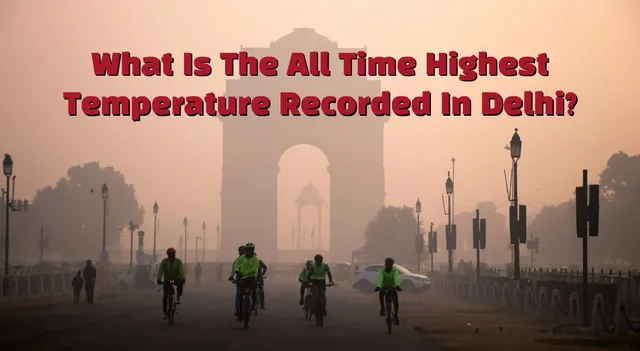- By Ridam Sharma
- Sat, 14 Jun 2025 06:20 PM (IST)
- Source:JND
Highest Temperature Recorded In Delhi: India is boiling under scorching heat, and Delhi is no different. Over the years, the national capital of India has experienced sweltering summers and record-breaking heat waves. Additionally, the city has experienced a steady rise in maximum temperatures, with recent years bringing unprecedented heat. Let’s take a look at Delhi’s temperature records, the factors behind these extremes, and a year-wise breakdown of the highest temperatures in recent years, according to the AQI data.
Temperature In Delhi Today: 14 June 2025
Delhi’s summer heat is at 38°C currently with 48% humidity, which is are little less heated than usual hot weather conditions. This city is suffering from constant heat, with outdoor activities becoming difficult for regular office goers and citizens in general. With rising temperatures every day, people can best remain hydrated and indoors in the peak afternoon sun.
Delhi’s All-Time Highest Temperature
The highest temperature recorded in Delhi was on May 29, 2024, when the weather station at Mungeshpur measured a record 52.3°C. This was more than a city record; it was the all-time highest temperature anywhere in India. But the India Meteorological Department (IMD) marked this reading as a suspicious one, indicating it may be the result of a sensor malfunction or local condition and initiated an inquiry to confirm its validity. On the same day, the Safdarjung observatory—a primary benchmarking location for city-wide temperature—recorded 46.8°C.
Also Read: What Are The Top 10 Hottest Cities In India Today ( June 13, 2025)?
The previous maximum temperature recorded in Delhi was 49°C, in 2022, in an intense heatwave.
Year-Wise Highest Temperatures In Delhi (2020-2025)
| Year | Highest Temperature (°C) | Notable Details |
| 2020 | 47.6 | Severe heatwave, Palam station |
| 2021 | 43.5 | Recorded in April, the hottest since 2020 |
| 2022 | 49.0 | Najafgarh, the city’s highest ever at the time |
| 2023 | 46.3 (Najafgarh), 42.9 (Safdarjung) | Heatwave-like conditions |
| 2024 | 52.3 (Mungeshpur, unverified), 46.8 (Safdarjung) | All-time Indian record (under review) |
| 2025 | 45.0 (Ayanagar), 43.9 (Safdarjung) | Ongoing heatwave, heat index up to 54.4°C |
2020: Delhi experienced a record heatwave, with Palam seeing 47.6°C, among the highest in recent memory.
2021: The city's top temperature was 43.5°C in April, the highest April day since 2020.
2022: Najafgarh reached 49°C, the new all-time high for the city at the time.
2023: While Safdarjung (the primary observatory) saw 42.9°C, Najafgarh reached 46.3°C, and several stations above 45°C.
2024: Mungeshpur's 52.9°C reading topped headlines as India's highest ever, although its veracity is disputed. Safdarjung's 46.8°C was an 80-year high.
2025: Through June, Ayanagar hit 45.0°C, and Safdarjung 43.9°C. The heat index (taking humidity into account) reached 54.4°C, making it feel even warmer.
Why Is Delhi Getting Hotter?
There are plenty of reasons for the national capital of India is facing severe weather conditions like urbanisation, as growing concrete surfaces retain more heat. Additionally, global warming is making heat waves more severe and extreme temperatures more frequent. The inland location of Delhi and proximity to the Thar Desert also make Delhi hot with dry winds.
Also Read: What Are The Top 10 Hottest Cities In India Today (14th June 2025)?
Severe heat in Delhi causes health hazards like heatstroke, dehydration, and more hospitalisations. Health officials declare heat waves and advise people to remain indoors and drink plenty of fluids to stay hydrated. Also, avoid physical activity during the hottest part of the day.
The temperature records of Delhi are a firm reminder of the increasing effects of climate change and urban heat. With the city crossing new records nearly every year, efficient urban planning, added green cover, and strong heat action plans are instrumental in protecting public health and well-being.

